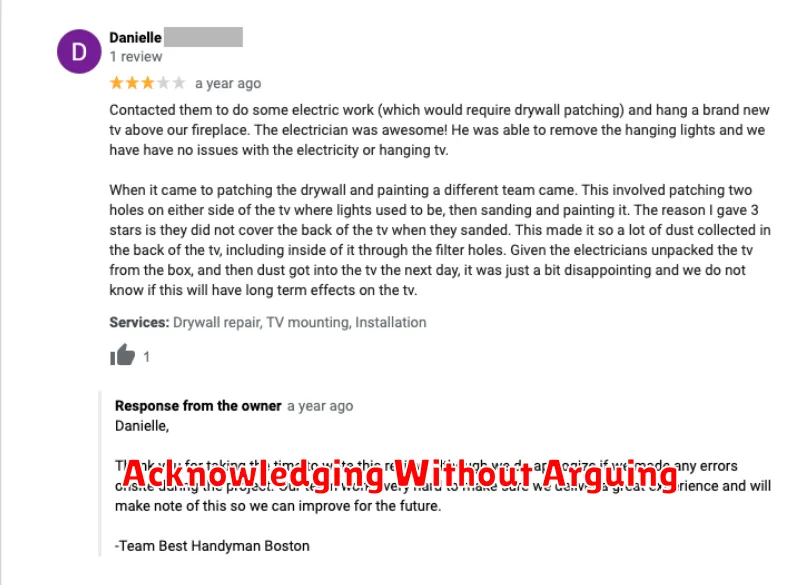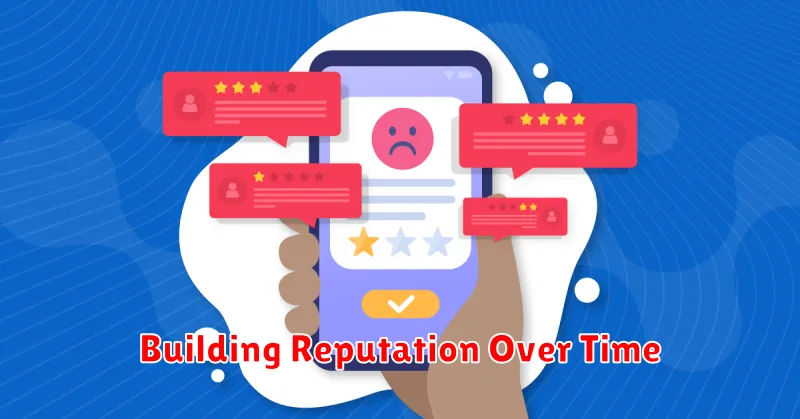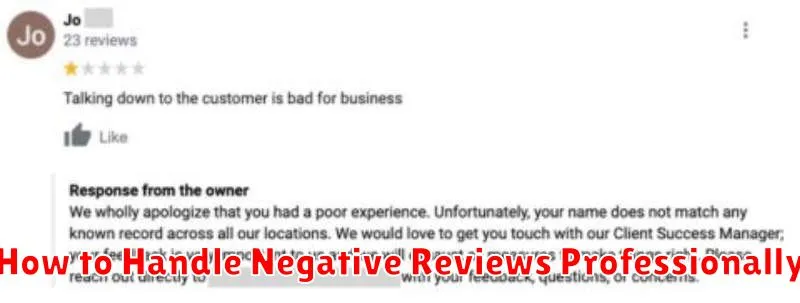Negative reviews are an inevitable part of doing business. Whether you run a small online shop or a large corporation, dissatisfied customers will occasionally voice their concerns publicly. While encountering negative reviews can be frustrating, responding to them professionally is crucial for maintaining a positive brand image and building customer trust. This article will guide you through the essential steps on how to handle negative reviews effectively and professionally, turning a potentially damaging situation into an opportunity for growth and demonstrating your commitment to customer satisfaction. Learning how to handle negative reviews is a vital skill for any business owner or customer service representative.
Ignoring negative reviews is not a viable solution. In today’s digital landscape, online reviews hold significant weight, influencing potential customers’ purchasing decisions. Addressing negative feedback professionally demonstrates accountability and a willingness to improve. This article outlines strategies for not only responding to negative reviews but also how to analyze them to identify underlying issues within your business. By understanding how to handle negative reviews effectively, you can protect your brand reputation, cultivate customer loyalty, and even gain valuable insights to enhance your products or services. Mastering the art of responding professionally to negative feedback is an essential component of successful business management.
Why Negative Reviews Can Be Helpful
While negative reviews can be discouraging, they can actually be valuable tools for growth and improvement.
Firstly, they offer direct feedback. Negative reviews highlight areas where your product or service may be falling short of customer expectations. This information can be used to identify specific weaknesses and implement changes to improve quality.
Secondly, negative reviews provide an opportunity to demonstrate your customer service skills. Responding professionally and empathetically to a negative review can show potential customers that you value their feedback and are committed to resolving issues.
Finally, negative reviews can add authenticity to your overall reviews. A mix of positive and negative reviews can feel more realistic and trustworthy to potential customers than a flawless stream of positive feedback.
Staying Calm and Professional
When confronted with a negative review, it’s crucial to maintain a calm and professional demeanor. Avoid reacting impulsively or defensively. Take a moment to breathe and gather your thoughts before responding.
Remember, negative reviews can be valuable opportunities for growth. They provide insight into areas where you can improve your products or services. Focus on addressing the reviewer’s concerns constructively and professionally, rather than becoming emotionally invested in the criticism.
Responding professionally will not only benefit the dissatisfied customer but also demonstrate your commitment to customer satisfaction to potential clients reading the reviews.
Responding Publicly vs Privately
Deciding whether to address negative reviews publicly or privately is a crucial step. Public responses are visible to all and demonstrate your commitment to customer satisfaction. They allow you to acknowledge the feedback, offer a solution, and potentially influence the perception of other potential customers.
Private responses, on the other hand, allow for a more personalized and discreet conversation. This approach can be more effective in resolving complex issues and diffusing tense situations without escalating the conflict in a public forum.
Choosing the right approach depends on the nature of the review, the platform, and your company’s policies. Sometimes, a combination of both public and private responses is the most effective strategy.
Acknowledging Without Arguing

Responding to negative reviews requires a delicate balance. You want to address the customer’s concerns without escalating the situation. Acknowledgment is the first crucial step. This doesn’t mean admitting fault if you genuinely believe there isn’t any. It simply means you’ve heard and understand the customer’s perspective.
Start by thanking the reviewer for their feedback. This sets a respectful tone. Then, rephrase their complaint to demonstrate your understanding. For example, instead of arguing a point, you can say something like, “We understand that you were disappointed with the wait time.” This validates their experience without necessarily agreeing with their interpretation.
Offering a Solution or Compensation
After acknowledging the reviewer’s experience and apologizing, offering a solution or compensation can significantly mitigate the impact of a negative review. This demonstrates a commitment to customer satisfaction and can turn a negative experience into a positive one.
Consider the nature of the complaint when deciding on the appropriate action. For minor issues, a simple apology may suffice. However, for more significant problems like a faulty product or poor service, offering a replacement, refund, or discount could be more appropriate.
Be proactive. Instead of simply waiting for the customer to request compensation, offer it upfront. This shows you value their feedback and are willing to take the necessary steps to rectify the situation.
Keep it private. When offering compensation, encourage the customer to contact you directly via email or phone. This allows you to address the issue privately and gather more information without further publicizing the complaint.
Turning a Bad Review Into Positive PR
A negative review isn’t always a disaster. Handled effectively, it can be an opportunity to demonstrate excellent customer service and build positive PR. Addressing the issue publicly shows other potential customers that you value feedback and are committed to resolving problems.
Start by responding promptly and professionally to the review. Acknowledge the customer’s concerns and apologize for any shortcomings. Offer a genuine solution to rectify the situation. This could involve a refund, discount, or simply a commitment to improve the area of concern.
Follow up with the customer to ensure they are satisfied with the resolution. If they are happy with the outcome, you can politely ask them to consider updating their review. Even if they don’t, your public response demonstrates a commitment to customer satisfaction which can boost your reputation.
Monitoring Review Sites Regularly
Regularly checking review sites is crucial for managing your online reputation. This allows you to address negative feedback promptly and demonstrate responsiveness to your customers.
Set up a system to monitor major platforms relevant to your business. This could involve using social listening tools or simply checking sites manually on a consistent schedule.
Early identification of negative reviews is key. It allows you to mitigate potential damage and demonstrate proactive customer service.
Training Staff to Prevent Issues
Proactive staff training is crucial in minimizing negative reviews. Well-trained staff can effectively address customer concerns before they escalate.
Implement regular training sessions focusing on customer service skills, product knowledge, and conflict resolution. This empowers staff to handle difficult situations with professionalism and empathy.
Role-playing scenarios can be beneficial, allowing staff to practice handling various customer interactions and develop effective communication strategies.
Encouraging Happy Customers to Share
While addressing negative reviews is crucial, actively encouraging satisfied customers to share their positive experiences is equally important. Positive reviews build a strong online reputation and can offset the impact of negative feedback.
Subtly prompt satisfied customers at key touchpoints. After a successful transaction or service completion, consider a simple request for a review. Make the process easy and convenient. Provide clear instructions or even direct links to review platforms.
Incentivizing positive reviews can be effective, but proceed with caution. Offer small rewards like discounts or loyalty points for sharing feedback. Ensure the incentive is for genuine feedback, not just positive reviews.
Building Reputation Over Time

While addressing negative reviews is crucial, building a strong online reputation is a continuous process. Consistency is key. Regularly monitor review platforms and engage with both positive and negative feedback.
Proactive reputation management involves soliciting reviews from satisfied customers. This helps to build a positive base, making occasional negative reviews less impactful. Encourage customers to share their experiences, and make the process as easy as possible.
Over time, a consistent stream of positive interactions and professional responses to negative feedback will cultivate trust and demonstrate your commitment to customer satisfaction. This strengthens your online presence and builds a resilient reputation that can withstand occasional negative experiences.

